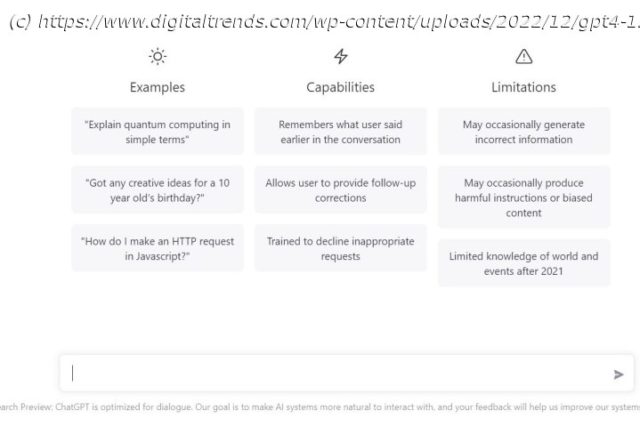The ChatGPT chatbot by OpenAI has taken the world by storm. Here’s how to use it and everything you need to know about AI text generation with GPT.
In the ever-evolving landscape of artificial intelligence, ChatGPT stands out as a groundbreaking development that has captured global attention. From its impressive capabilities and recent advancements to the heated debates surrounding its ethical implications, ChatGPT continues to make headlines.
Whether you’re a tech enthusiast or just curious about the future of AI, dive into this comprehensive guide to uncover everything you need to know about this revolutionary AI tool.What is ChatGPT?
ChatGPT is a natural language AI chatbot. At its most basic level, that means you can ask it a question and it will generate an answer. As opposed to a simple voice assistant like Siri or Google Assistant, ChatGPT is built on what is called an LLM (Large Language Model). These neural networks are trained on huge quantities of information from the internet for deep learning — meaning they generate altogether new responses, rather than just regurgitating canned answers. They’re not built for a specific purpose like chatbots of the past — and they’re a whole lot smarter.
This is implied in the name of ChatGPT, which stands for Chat Generative Pre-trained Transformer. In the case of the current version of ChatGPT, it’s based on the GPT-4 LLM. The model behind ChatGPT was trained on all sorts of web content including websites, books, social media, news articles, and more — all fine-tuned in the language model by both supervised learning and RLHF (Reinforcement Learning From Human Feedback). OpenAI says this use of human AI trainers is really what makes ChatGPT stand out.When was ChatGPT released?
ChatGPT was originally launched to the public in November of 2022 by OpenAI. That initial version was based on the GPT-3.5 model, though the system has undergone a number of iterative advancements since then with the current version of ChatGPT running the GPT-4 model family, with GPT-5 reportedly just around the corner. GPT-3 was first launched in 2020, GPT-2 released the year prior to that.How to use ChatGPT
First, go to chatgpt.com. If you’d like to maintain a history of your previous chats, sign up for a free account. You can use the system anonymously without a login if you prefer. Users can opt to connect their ChatGPT login with that of their Google-, Microsoft- or Apple-backed accounts as well. At the sign up screen, you’ll see some basic rules about ChatGPT, including potential errors in data, how OpenAI collects data, and how users can submit feedback. If you want to get started, we have a roundup of the best ChatGPT tips.
Using ChatGPT itself is simple and straightforward, just type in your text prompt and wait for the system to respond. You can be as creative as you like, and see how your ChatGPT responds to different prompts. If you don’t get the intended result, try tweaking your prompt or giving ChatGPT further instructions The system understands context based on previous responses from the current chat session, so you can refine your requests rather than starting over fresh every time.
For example, starting with “Explain how the solar system was made” will give a more detailed result with more paragraphs than “How was the solar system made,” even though both inquiries will give fairly detailed results. Take it a step further by giving ChatGPT more guidance about style or tone, saying “Explain how the solar system was made as a middle school teacher.”
You also have the option for more specific input requests, for example, an essay with a set number of paragraphs or a link to a specific Wikipedia page. We got an extremely detailed result with the request “write a four-paragraph essay explaining Mary Shelley’s Frankenstein.”
ChatGPT is capable of automating any number of daily work or personal tasks from writing emails and crafting business proposals, to offering suggestions for fun date night ideas or even drafting a best man’s speech for your buddy’s wedding. So long as the request doesn’t violate the site’s rules on explicit or illegal content, the model will do its best to fulfill the commands.
Since its launch, people have been experimenting to discover everything the chatbot can and can’t do — and the results have been impressive, to say the least. Learning the kinds of prompts and follow-up prompts that ChatGPT responds well to requires some experimentation though. Much like we’ve learned to get the information we want from traditional search engines, it can take some time to get the best results from ChatGPT. It really all depends on what you want out of it. To start out, try using it to write a template blog post, for example, or even blocks of code if you’re a programmer.
Our writers experimented with ChatGPT too, attempting to see if it could handle holiday shopping or even properly interpret astrological makeup. In both cases, we found limitations to what it could do while still being thoroughly impressed by the results.
Following an update on August 10, you can now use custom instructions with ChatGPT. This allows you to customize how the AI chatbot responds to your inputs so you can tailor it for your needs. You can’t ask anything, though. OpenAI has safeguards in place in order to “build a safe and beneficial artificial general intelligence.” That means any questions that are hateful, sexist, racist, or discriminatory in any way are generally off-limits.
You shouldn’t take everything that ChatGPT (or any chatbot, for that matter) tells you at face value. When ChatGPT first launched it was highly prone to “hallucinations.” The system would repeat erroneous data as fact. The issue has become less prevalent as the model is continually fine tuned, though mistakes do still happen. Trust but verify!
What’s more, due to the way that OpenAI trains its underlying large language models — whether that’s GPT-3.5, GPT-4, GPT-4o, GPT-4o mini, or the upcoming GPT-5 — ChatGPT may not be able to answer your question without help from an internet search if the subject is something that occurred recently. For example, GPT-3.5 and 3.5 Turbo cannot answer questions about events after September 2021 without conducting an internet search to find the information because the data that the model was initially trained on was produced before that “knowledge cutoff date.” Similarly, GPT-4 or GPT-4 Turbo have cutoff dates of December 2023, though GPT-40 and GPT-4o mini (despite being released more recently) have a cutoff of October 2023.
While ChatGPT might not remember all of recorded history, it will remember what you were discussing with it in previous chat sessions. Logged in users can access their chat history from the navigation sidebar on the left of the screen, and manage these chats, renaming, hiding or deleting them as needed. You can also ask ChatGPT follow up questions based on those previous conversations directly through the chat window. Users also have the option to use ChatGPT in dark mode or light mode.
ChatGPT isn’t just a wordsmith. Those users paying $20/month subscription for ChatGPT Plus or $30/month/user for ChatGPT Business, gain access to the Dall-E image generator, which converts text prompts into lifelike generated images. Unfortunately, this feature is not currently available to the free tier. Regardless of subscription status, all users can use image or voice inputs for their prompt.How to use the ChatGPT iPhone, Android, and Mac apps
ChatGPT is available through the OpenAI web, as well as a mobile app for both iOS and Android devices. The iOS version was an immediate hit when it arrived at the App Store, topping half a million downloads in less than a week.
If you can use ChatGPT on the web, you can use it on your phone. Logging on or signing up through the app is nearly identical to the web version and nearly all of the features found on the desktop have been ported to the mobile versions. The app lets you toggle between GPT-4o mini, GPT-4, and GPT-4o as well. The clean interface shows your conversation with GPT in a straightforward manner, hiding the chat history and settings behind the menu in the top right.
Some devices go beyond just the app, too. For instance, the Infinix Folax is an Android phone that integrated ChatGPT throughout the device. Instead of just an app, the phone replaces the typical smart assistant (Google Assistant) with ChatGPT.
There’s even an official ChatGPT app released for the Mac that can be used for free. The app is capable of all sorts of new things that bring Mac AI capabilities to new levels — and you don’t even have to wait for macOS Sequoia later this year.Is ChatGPT free to use?
Yes, ChatGPT is completely free to use, though with some restrictions. Even with a free tier account, users will have access to the GPT-4o and GPT-40 mini models, though the number of queries that users can make of the larger model are limited. Upgrading to a paid subscription drastically increases that query limit, grants access to other generative AI tools like Dall-E image generation, and the ability to create custom GPTs.






